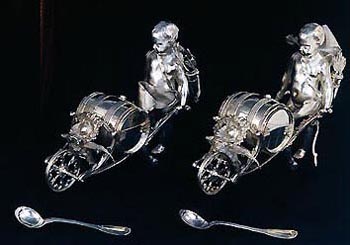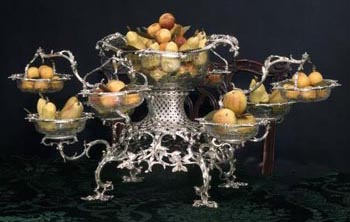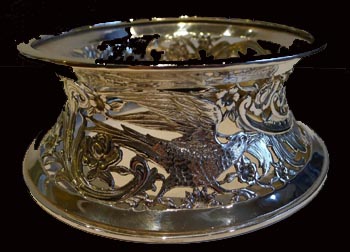A true democracy, Pius XII asserted, should have institutions with an aristocratic tone (cf. Allocution of January 16, 1948 to the Roman Nobility). If it had not been the illustrious Pontiff who said this, the derision, defamations and persecutions of the revolutionary egalitarianism would have fallen furiously on one who dared to make such an affirmation.

Salt cellars; below, epergne
 |
But since it was Pius XII who said it, the revolutionary democratism does whatever it can to hide this sentence and cast it into oblivion. If it is cited, the revolutionary maintains an abashed but furious silence, turning a look that could kill toward anyone so insolent as to dare exhume this uncomfortable pontifical text.
Since we are accustomed to completely disregard the furor of the partisans of a revolutionary democratism, we not only exhume this text, but will comment on it. More than comment on it, we will do something that irritates the revolutionary even more, we will illustrate it.
From a certain point of view, that aristocratic tone of which Pius XII speaks constitutes the highest affirmation of human dignity, the manifestation of what in it is profoundly honorable.
In this sense literary, artistic, social institutions (and even, in its own way, worker guilds) that are imbued with an aristocratic tone by stimulating the formation of authentic elites in the various domains of human activity, enhance, elevate and dignify the whole social body. These institutions constitute a factor for dignifying man whatever be his place in the social hierarchy.
A man sits down at his table not only to nourish his body, but also to tranquilly rest with his family in a calm, pleasant and serene conviviality.

Porcelains;below, Irish napkin ring
 |
For this reason, the objects that surround him during his meals should invite him to the repose, relaxation and affability proper to a decorous domestic intimacy.
Our photographs show a series of small table objects from the 18th century. The readers who have an appreciation for art will readily recognize that these small objects are authentic masterpieces designed to provide a pleasure of spirit to the man who sees them or uses them in the service of the table. The delicacy, distinction and charm they possess attest to the presence of a truly aristocratic tone and indicate a high respect for the spiritual conveniences of man even in the prosaic existence of his daily life.
Naturally, in that time, these high standards of culture were proportionally diffused throughout the whole social body, with due nuances. It was not a monopoly of the nobility, but, on the contrary, represented a stimulus that inspired all in due measure. From there comes the beauty of table objects even in modest stratums of society.
The pieces exhibited here are a proof of how much this spirit was present in the entire social body.
If fact, even when these objects were for the use of the higher classes, they express not only the tone that the nobles communicated to life, but also the marvelous taste of the artists and artisans – who habitually came from the people – who conceived and executed these small masterpieces.
Translated from Catolicismo, n.162 - June 1964
Posted August 1, 2012

|